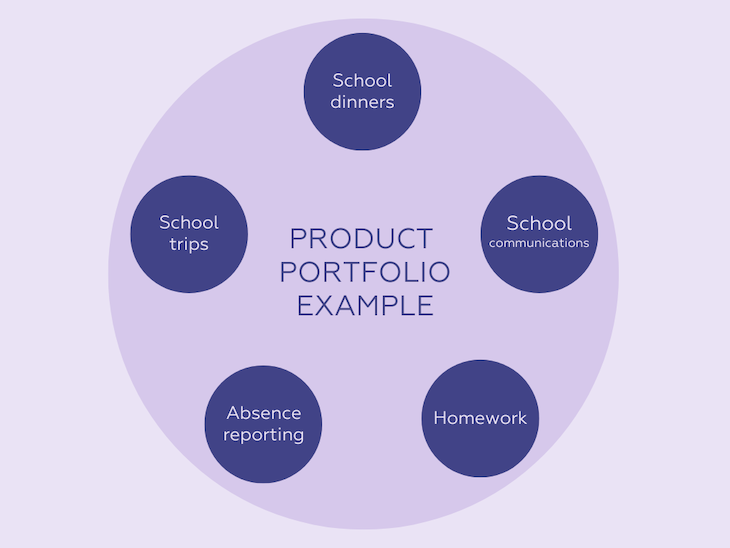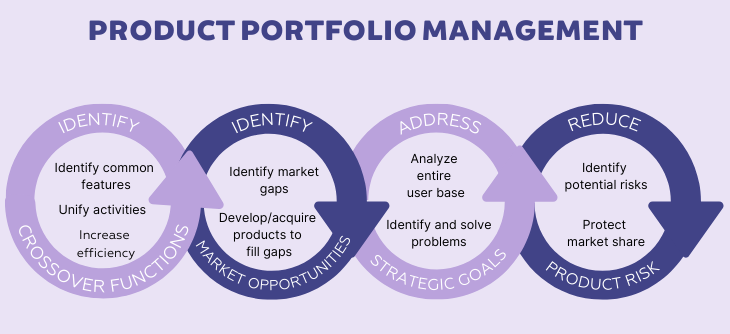Businesses usually start with an idea of how to solve a problem. Hard work and inspiration leads to the development of a solution and thus, a product is born.

Over time, products develop and expand to address new use cases that are uncovered. This may mean expanding the features of an existing product or developing brand new products to sit alongside it.
In addition, rather than develop new products to join the original, the company can purchase other companies and products to fill the gap that it has identified.
However you get there, once you find yourself with multiple products operating within the same organization, you have a product portfolio.
In organizations that hold numerous products, the role of product management can be expanded. This is when product portfolio management (PPM) comes in to address the product management responsibility across all of the products.
Where a product manager takes responsibility for the development and success of an individual product, a product portfolio manager will be looking at numerous products, how they work together, and how they all function within the market.
For example:
Let’s say we have a company that operates in the education industry. When it is still young, it offers one product that enables parents to pay for school dinners online.
Over time, the company develops or purchases products that cover school-to-parent communications, assigning homework, absence reporting, and managing school trips.
This company now has a portfolio of products that should work together in the market:

Each product has its own product manager, but PMs are only focused on delivering in their own specific area. The product portfolio manager is responsible for looking across all the products to identify synergies, operational deficiencies, and opportunities within the wider edtech market.
The tasks of a PPM are both close to those of a standard product manager and also distinctly different.
The primary objectives of a product portfolio manager are to:

Let’s zoom in on these key tasks from the perspective of our example education product provider.
When taking a look at the features of both the school dinners app and the school trips app, the PPM might identify that both apps share common use cases and associated features.
Individually, each app’s product manager wouldn’t be looking at ways in which their product can be combined with others because they would be focused on their own engagement metrics, satisfaction scores, etc. The PPM is in a position to look across all products and identify opportunities to move toward a single application for all school payments.
By identifying common features, the PPM can work to consolidate activities, which brings with it economies of operation and more clarity within the market. Without the outlook of a PPM, the organization runs the risk of operating inefficiently, wasting resources, cannibalizing its own customer base, and missing innovative opportunities.
An individual PM for the school dinner app is responsible for identifying and analyzing other competing apps for differentiating factors that might draw customers in. The portfolio manager, on the other hand, spends time looking at the wider education market to identify potential opportunities that align with gaps in the current product portfolio.
Maybe PPMs can identify holes in a system that schedules parent-teacher conferences, and find that presently, there isn’t a product within the portfolio that can meet those needs. This will allow the organization to move forward in this direction through the development or acquisition of a product that solves this issue.
Without the wider view of the PPM, organizations run the risk of missing these opportunities and letting competitors overtake the market, which could damage the existing product performance.
The PM for the school communications app might follow strategic goals focused around increasing the user base and improving conversion through the sign up flow, product sharing tools, and school engagement. However the PPM’s purview is wider than this.
The PMM is responsible for looking at the user base across the entire product portfolio. This might enable them to identify, for example, that customer growth has slowed across the elementary school demographic, which might lead to a strategic decision to move into the high school market. The PPM can now assess the portfolio and determine the best way to make this happen.
The PM for the school homework app has to work hard to ensure the success of their product but given their narrow focus, they may not be in a position to identify potential risks within this space. On the other hand, the PPM, with their wider remit, might be able to.
A PPM understands that products have certain lifespans and is in a position to identify where a product might begin to face difficulties. They can then line up alternative products to protect the overall organizational market share.
Maybe the transition to remote learning will reduce the need for a homework-specific application because work is increasingly assigned and completed alongside lesson broadcasting tools. The PPM would take responsibility for addressing this risk, either through expansion of the school homework app to cater to remote learning or through the introduction of a remote learning product. Without this viewpoint, there are risks that the existing products will become overtaken by the competition and push overall organizational performance down.
There are several very popular tools within product portfolio management, and each one looks at a different aspect of product portfolio analysis. The tools include:
Each matrix looks at how the products within the portfolio sit against a set of criteria and is designed to allow the PPM to determine how to approach the wider opportunities or risks within the market.
Whatever the outcome, the result for the PPM will be a plan to address the situation with a(n):
The results of these assessments can be brought to life through portfolio-level roadmaps. This shows the strategic direction across all products within the portfolio and illustrates how the product activities across the organization are complementary and supportive of the set strategic goals.
The most obvious answer to this question is: only if you have a portfolio of products. However, how many products do you need for it to be called a portfolio?
In reality, once you get into a situation where you have a number of distinct, but complementary, products within a particular market, then there is an opportunity for a PPM to oversee all these products. The PPM can add some value by having a holistic view of your products in the market and can make strategic decisions on how best they should be positioned to deliver the best results.
Featured image source: IconScout
LogRocket identifies friction points in the user experience so you can make informed decisions about product and design changes that must happen to hit your goals.
With LogRocket, you can understand the scope of the issues affecting your product and prioritize the changes that need to be made. LogRocket simplifies workflows by allowing Engineering, Product, UX, and Design teams to work from the same data as you, eliminating any confusion about what needs to be done.
Get your teams on the same page — try LogRocket today.

Red-teaming reveals how AI fails at scale. Learn to embed adversarial testing into your sprints before your product becomes a headline.

Cory Bishop talks about the role of human-centered design and empathy in Bubble’s no-code AI development product.

Learn how to reduce mobile friction, boost UX, and drive engagement with practical, data-driven strategies for product managers.

Jim Naylor shares he views documentation as a company’s IP and how his teams should use it as a source of truth.